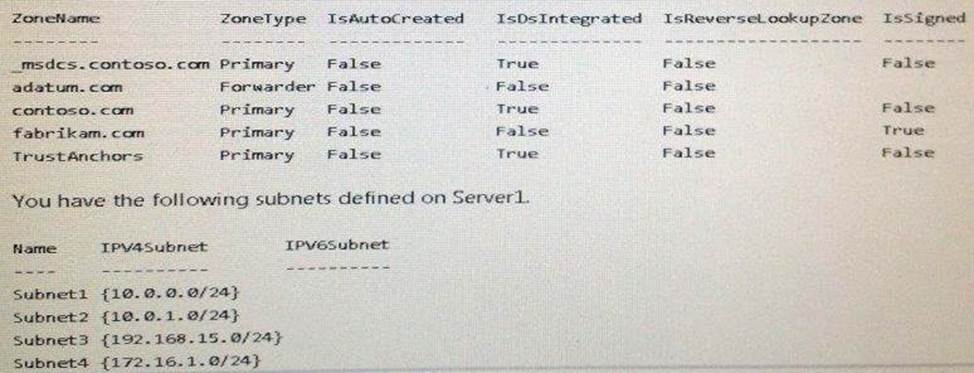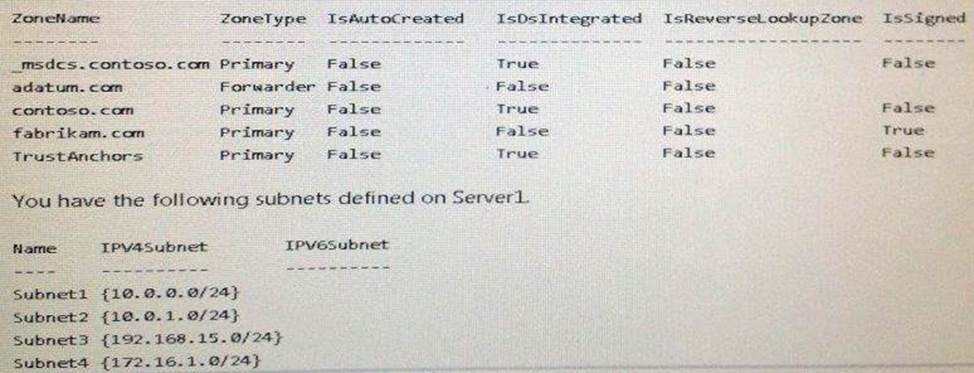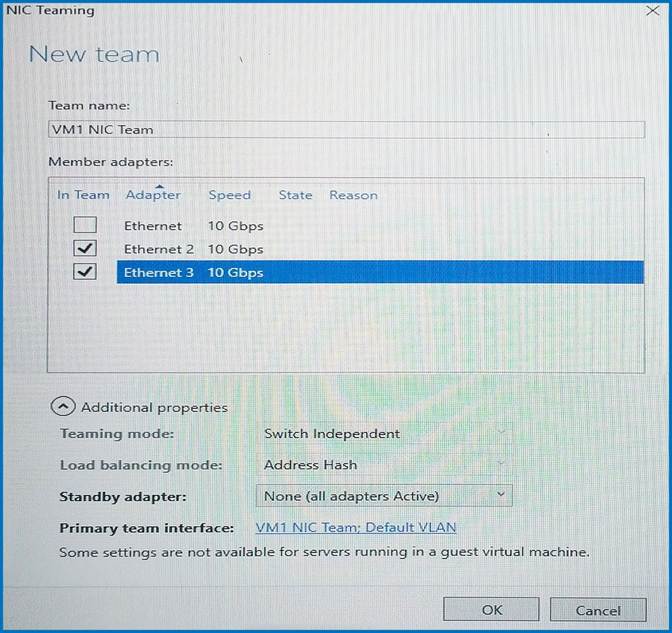Microsoft 70-743 Microsoft Upgrading Your Skills to MCSA: Windows Server 2016 Online Training
Microsoft 70-743 Online Training
The questions for 70-743 were last updated at Dec 18,2025.
- Exam Code: 70-743
- Exam Name: Microsoft Upgrading Your Skills to MCSA: Windows Server 2016
- Certification Provider: Microsoft
- Latest update: Dec 18,2025
Note: This question is part of a series of questions that present the same scenario. Each question in the series contains a unique solution. Determine whether the solution meets the stated goals.
In this section, you’ll see one or more sets of questions with the same scenario and problem. Each question presents a unique solution to the problem, and you must determine whether the solution meets the stated goals. Any of the solutions might solve the problem. It is also possible that none of the solutions solve the problem.
Once you answer a question in this section, you will NOT be able to return to it. As a result, these questions will not appear in the review screen.
Your network contains an Active Directory domain named contoso.com. The domain contains a DNS server named Server1. All client computers run Windows 10.
On Server1, you have the following zone configuration.

You need to prevent Server1 from resolving queries from DNS clients located on Subnet4. Server1 must resolve queries from all other DNS clients.
Solution: From windows PowerShell on Server1, you run the Add-DnsServerTrust Anchor cmdlet.
Does this meet the goal?
- A . Yes
- B . No
Your network contains an Active Directory domain named contoso.com. The domain contains a DNS server named Server1. All client computers run Windows 10.
On Server1, you have the following zone configuration

You need to prevent Server1 from resolving queries from DNS clients located on Subnet4. Server1 must resolve queries from all other DNS clients.
Solution: From Windows PowerShell on Server1, you run the Export-DnsServerDnsSecPublicKey cmdlet.
Does this meet the goal?
- A . Yes
- B . No
Your Network contains one Active Directory domain named contoso.com.
You pilot DirectAccess on the network.
During the pilot deployment, you enable DirectAccess only for a group ContosoTest Computers.
Once the pilot is complete, you need to enable DirectAccess for all the client computers in the domain.
What should you do?
- A . From Windows PowerShell, run the Set-DAClient cmdlet.
- B . From Windows PowerShell, run the Set-DirectAccess cmdlet.
- C . From Active Directory Users and Computers, modify the membership of the Windows Authorization Access Group.
- D . From Group Policy Management, modify the security filtering of an object named Direct Access Client Setting Group Policy.
You have a server named Server1.
You enable BitLocker Drive Encryption (BitLocker) on Server1.
You need to change the password for the Trusted Platform Module (TPM) chip.
What should you run on Server1?
- A . Initialize-Tpm
- B . Import-TpmOwnerAuth
- C . repair-bde.exe
- D . bdehdcfg-exe
You have two servers named Server1 and Server2. A firewall exists between Server1 and Server2.
Both servers run Windows Server Update Services (WSUS). Server1 downloads updates from Microsoft update.
Server2 must synchronize updates from Server1.
Which port should to open on the firewall?
- A . 80
- B . 443
- C . 3389
- D . 8530
Note: This question is part of a series of questions that present the same scenario. Each question in the series contains a unique solution that might meet the stated goals. Some question sets might have more than one correct solution, while others might not have a correct solution.
After you answer a question in this section, you will NOT be able to return to it. As a result, these questions will not appear in the review screen. Your network contains an Active Directory forest named contoso.com.
You need to identify which server is the schema master.
Solution: You open Active Directory Users and Computers, right-click contoso.com in the console tree, and then click Operations Master.
Does this meet the goal?
- A . Yes
- B . No
Note: This question is part of a series of questions that present the same scenario. Each question in the series contains a unique solution that might meet the stated goals. Some question sets might have more than one correct solution, while others might not have a correct solution.
After your answer a question in this section, you will NOT be able to return to it. As a result, these questions will not appear in the review screen. Your network contains an Active Directory forest named contoso.com. You need to identify which server is the schema master.
Solution: From a command prompt, you run netdom query fsmo.
Does this meet the goal?
- A . Yes
- B . No
Note: This question is part of a series of questions that present the same scenario. Each question in the series contains a unique solution that might meet the stated goals. Some question sets might have more than one correct solution, while others might not have a correct solution.
After your answer a question in this section, you will NOT be able to return to it. As a result, these questions will not appear in the review screen.
Your network contains an Active Directory forest named contoso.com.
You need to identify which server is the schema master.
Solution: From Windows PowerShell, you run Get-ADDomainController -Discover -Service 2.
Does this meet the goal?
- A . Yes
- B . No
You have a server named Server1 that runs Windows Server 2016. The Docker daemon runs on Server1.
You need to configure the Docker daemon to accept connections only on TCP port 64500.
What should you do?
- A . Run the sc control command.
- B . Run the New-NetFirewallRule cmdlet.
- C . Modify the routing table on Server1.
- D . Run the sc config command.
You have a server named Server1 that runs Windows Server 2016. Server1 is a Hyper-V host that hosts a virtual machine named VM1.
Server1 has three network adapter cards that are connected to virtual switches named vSwitch1, vSwitch2 and vSwitch3.
You configure NIC Teaming on VM1 as shown in the exhibit. (Click the Exhibit button.)

You need to ensure that VM1 will retain access to the network if a physical network adapter card
fails on Server1.
What should you do?
- A . From the properties of the NIC team on VM1, change the load balancing of the NIC team.
- B . From Hyper-V Manager on Server1, modify the settings of VM1.
- C . From Windows PowerShell on Server1, run the Set-VmNetworkAdapterFailoverConfigurationcmdlet.
- D . From Hyper-V Manager on Server1, modify the properties of vSwitch1.
Latest 70-743 Dumps Valid Version with 252 Q&As
Latest And Valid Q&A | Instant Download | Once Fail, Full Refund

